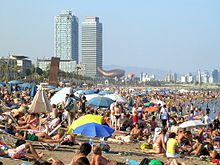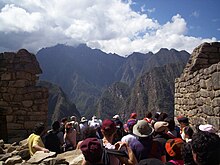Type a search term to find related articles by LIMS subject matter experts gathered from the most trusted and dynamic collaboration tools in the laboratory informatics industry.

Overtourism is congestion or overcrowding from an excess of tourists, resulting in conflicts with locals. The World Tourism Organization (UN Tourism) defines overtourism as "the impact of tourism on a destination, or parts thereof, that excessively influences perceived quality of life of citizens and/or quality of visitor experiences in a negative way".[1][2][3][4] This definition shows how overtourism can be observed both among locals, who view tourism as a disruptive factor that increasingly burdens daily life, as well as visitors, who may regard high numbers of tourists as a nuisance.
The term was only used infrequently before 2017, but is now the most commonly used expression to describe the negative impacts ascribed to tourism.[5]


The growth of tourism can lead to conflicts between residents, commuters, day-visitors and overnight tourists.[6] Although much attention is currently given to overtourism in cities, it can also be observed in rural destinations, or on islands.[7] The World Tourism Organization (UNWTO) found that a perception of overcrowding can prompt local residents to protest against tourism. The excessive growth of visitors can lead to negative effect for local residents, especially during temporary or seasonal tourism peaks. Therefore, the carrying capacity of a tourist destination is also measured in terms of social carrying capacity, and the behaviour of the tourists.[8]
Overtourism is sometimes incorrectly equated with mass tourism. Mass tourism entails large groups of tourists coming to the same destination. While this can lead to overtourism, there are many destinations that host millions of visitors, yet are not seen as suffering from overtourism (e.g., London).[5] Tourists usually use infrastructure and services designed for residents. If the carrying capacity is exceeded of the infrastructure and services tourists need to use as well, the service provision focuses on the priorities of the tourists. Residents may be forced to use the service provision intended for tourists.[9]
In the 1990s local residents in Spain, Greece, Malta, and France started to oppose mass tourism, which was perceived as Fordist. In rural areas of Latin America, environmental concerns were the key driver for rising discontent and social campaigns against tourist real estate developments. In Mexico and Central America vehement protests were triggered by tourist real estate speculation alongside the exploitation of workers, and even dispossession or displacement of local residents.[10]
In 2017 Europe saw a wave of residents' protests in cities, including Barcelona, Venice, and Palma de Mallorca. The problems arising from overtourism began to be discussed in academic publications, but no commonly accepted definition of the phenomenon has been agreed on.[11]

Overtourism is observed mostly, but not exclusively, when the number of visitors to a destination, or parts thereof, grows rapidly in a short space of time. Also, it is most common in areas where visitors and residents share a physical space.[12] In recent years, developments within tourism and outside of tourism have increased contact between residents and visitors and made the impacts of tourism more noticeable.[13] In addition to the overall growth of tourist numbers, problems associated with overtourism have been exacerbated by the following developments:[5][1]
Overtourism has developed into a widespread phenomenon. Governments and destination marketing organizations are attempting to address the problem. Enablers of overtourism include greater numbers of tourists, the affordability of travel, a mindset dominated by the wish for economic growth, short term focus on tourism, the competition for local services and amenities, and lack of control over tourist bookings.[14]
There are currently more tourists than ever before in world history. In 1950 the number of international tourists was estimated to be 25 million. In 1963 Walter Christaller published on the negative effects of tourism. In 1987 Jost Krippendorf followed as international tourist travel increased. In 2016 tourists numbered over a billion, a 50-fold increase compared to 1950. Media coverage on overtourism has focused on Europe, which bears the brunt of tourism arrivals with 50 percent, and South East Asia, which sustains 25 percent of tourism arrivals.[14] According to UNWTO there were 25 million international arrivals in 1950, which increased to 1.3 billion by 2017. The international tourism sector is expected to grow 3.3% annually, until 2030, a year at which point an expected 1.8 billion tourists will cross borders.[15]

The rise of low-cost carriers (LCCs), the availability of inexpensive intercity bus service, and the popularity of cruise ship travel are assumed to have contributed to complaints about overtourism. In academic literature government policy, the ambitions of service providers in tourist destinations, as well as the influence of social media are considered enablers of overtourism.[11]
Airbnb and similar online accommodation services can lead to an increase in tourists due to lower prices, compared to hotels or other establishments.[citation needed] There is also the issue of Airbnb's leading to fewer affordable housing opportunities for residents, increased rent prices, and loss of social community within neighborhoods.[18]
The experience economy and changing lifestyle patterns have been blamed for the increased use of leisure facilities, contributed to a monoculture of hospitality facilities.[citation needed]
As of 2017, several media outlets published lists of destinations that are not recommended because of an excessive number of tourists.[19][20]
According to CNN, environmentalists are concerned about the effect of tourism on Antarctica, which steadily increased during the 2010s.[20] The total number of visitors to Antarctica, as registered by the International Association of Antarctica Tour Operators (IAATO) in the 2023-24 summer season was 122,072. Cruise-only vessels (i.e. vessels not putting travelers on shore) accounted for 35% of the visitors.[21]
In Aruba, the chemical Oxybenzone in sunscreen is harming coral reefs and marine life. In 2019 a proposed law called "Choose Zero" was introduced, which includes a ban on importing, selling, or distributing single-use plastic products and products containing Oxybenzone.[22][23]
Hallstatt in 2020 had 780 citizens and more than 10,000 visitors a day, primarily arriving via tour bus, stopping briefly for photographs, and moving on quickly.[24] Citizens complained about tourists entering homes and private gardens to take photos, or applauding funerals at the churchyard.[25] In 2020, the town implemented a system to limit entry of buses.[26][27][28]
Bhutan instituted a US$200 to US$250 charge per day for tourists because of overtourism concerns.[20]
The Great Wall of China has been damaged by overtourism.[29]
Dubrovnik became so overtouristed by 2017 that UNESCO considered removing it from the World Heritage Site list.[20] The city capped the number of visitors allowed to climb its ramparts and as of 2017 was planning to limit the number of cruise ships that could dock.[20][30] In 2020 they were considering limiting the number of new restaurants allowed to open.[31]
The Galápagos Islands were included on Fodor's 2017 list of places not to go because of environmental damage caused by overtourism.[29] As of 2017 visitors are required to hire a guide.[20]

In Paris, workers at the Louvre went on strike over what they said were dangerously overcrowded conditions.[32]
In Santorini cruise ship visitors have been capped at 8000 per day due to overtourism[20] after years in which the island of 15,000 residents was receiving up to 18,000 tourists per day.[31]
The Zugspitze has been plagued by overtourism, especially because of day trippers arriving via gondola.[33]
The European Alps experience a raise in accidents and deaths, since many tourists underestimate the difficulty of mountain routes, and go mountaineering with insufficient equipment or low fitness and stamina.[34]
In Hawaii the degradation of corals has been shown to worsen in areas with higher concentration of tourists.[35]
The Fjaðrárgljúfur area was closed after the music video for Justin Bieber's I'll Show You made it so popular the government needed to improve infrastructure.[31][36]
Tourism in Iceland is predominantly nature based and therefore comes with the challege protecting the environment with the increase in tourism to the country. Overuse of natural areas can cause long-lasting and possibly permanent damage to vegetation, soils, and the landscape. With the rapid growth, there is also a lack of infrastructure on the island to fully support the increase in tourism, alongside an already present population. This causes further issues such as traffic on roads that can be difficult to travel.[37][38]
In 2019 the Taj Mahal started fining visitors who stay more than three hours.[39] CNN in 2017 called the crowds "relentless".[20]
Bali was, in 2020, planning a US$10 tourist tax.[31]
Abyaneh's overtourism is often reported on.[40]
Iraqi Kurdistan is the most toured part of Iraq, especially during Newroz. Tourists come from all around Iraq and the world for Newroz. In Duhok, 3 people were arrested for planning to burn 200 tires for the Newroz fire in 2022.[41][42] In Akre, a city famous for its Newroz celebrations, some locals decided to burn wooden torches instead of tires.[43]

Venice has faced declining population because of overtourism.[28] In 2019 Forbes called it one of the "most notably overtouristed destinations" in the world.[44] CNN in 2017 called the crowds "overbearing."[20] The city in 2018 tested the use of turnstiles in St. Mark's Square to control the number of visitors.[28] In 2020 the daily tourist tax was US$11.[31]
Capri in 2018 tested ways to limit day tourism.[28] Cinque Terre had 2.5 million visitors in 2015, and local authorities sought to limit visitors to 1.5 million in 2016, but a backlash resulted in this being walked back.[20] CNN in 2017 said that day tourists from cruise ships, who tour for a few hours and don't spend money, are blamed for environmental damage.[20] Officials in Rome made it illegal to sit on the Spanish Steps, with fines of up to US$448, due to damage caused by tourists.[20]
In the 2010s Pragser Wildsee became an area of overtourism, receiving up to 17,000 visitors on a single summer day in 2020; as of 2023, there were vehicle access restrictions.
The government of Florence is currently seeking to ban new short-term rental properties in the city's historic center, which is a UNESCO World Heritage Site. The city's administration argues that the increased availability of short-term rentals through platforms such as Airbnb, which cater to tourists, have made housing inaccessible for local residents.[45]
Kyoto officials instituted a US$92 fine for tourists taking photographs of geisha without their permission,[24] and prohibited tourists from visiting some alleys.[46]
The end of COVID-19-related travel restrictions and a weakening Japanese yen have fueled a record-breaking surge in foreign tourism.[47] In response to a surge in foreign tourists at Mount Fuji, Yamanashi Prefecture has set a cap of daily climbers at 4,000 people and began charging an entrance fee of ¥2,000.[48] Also in Yamanashi Prefecture, a mesh barrier was set up to block a view of Mount Fuji behind a Lawson convenience store in Fujikawaguchiko due to tourist-caused disturbances in the area.[49] Tokyo's Shibuya ward restricted Halloween and New Year's Eve gatherings at Shibuya Crossing (which had not been held since 2019 due to COVID-19 and safety issues) in 2023 due to issues with public intoxication caused by overtourism, and introduced an ordinance in 2024 which prohibits public alcohol consumption from 6 p.m. to 5 a.m. year-round (expanding from late-October and late-December).[50][51][52][53]
As of 2024 some Japanese officials have considered instituting a two-tiered pricing system which would have foreign tourists pay more than residents at certain tourist attractions to counter the effects of overtourism.[54][55]
Mount Everest has become so overtouristed that climbers die of altitude sickness because of the delays caused by overcrowding.[44] As of 2020 the Nepalese government was planning to limit permits to those who had climbed another Nepalese peak 21,325 feet (6,500 m).[31]
Amsterdam instituted a daily tourist tax in 2019,[56] eliminated official tours of the Red Light District in 2020,[57] and launched a "Stay Away" marketing campaign.[46]

As of 2019, Peru limits visitors to Machu Picchu to 5000 per day, but UNESCO believes the limit should be halved.[44] Starting in 2014 foreign tourists were required to hire a guide.[20] In 2020 the site was planning to issue 5,940 tickets per day, which is more than twice the 2,500 UNESCO recommends to preserve the ruins.[31]
Sintra suffers from long queues, pollution, traffic, and a lack of grocery stores and pharmacies due to receiving 5,000 visitors a day for attractions such as Pena Palace.[58]
In Barcelona protesters have demonstrated in tourist beaches and other tourist-heavy neighborhoods and anti-tourist graffiti has appeared.[20][59] By 2013, 9,000,000 visitors were touring Park Güell annually, and officials limited entry to the park to 800 an hour.[59] The New Yorker said, "Park Güell’s shift from a shared public space into a cultural zone occupied almost exclusively by tourists is understood by some worried residents of Barcelona as a story about the prospective fate of the city itself."[59] According to Albert Arias, a geographer with the Barcelona government, the selling of tickets was "a very bad solution," that "is acknowledging a problem by fencing off public space."[59] Airbnb has contributed to overtourism, with in some sections of town experiencing a 45% decline in resident population between 2007 and 2019 due to investors purchasing properties to use as short-term rentals via the platform.[59] By 2017 tourism had become a top concern among city officials, with a survey showing 60% of residents believed Barcelona had "reached or exceeded" its capacity to accommodate tourism.[59] In 2020 Barcelona was planning to limit cruise ships.[31] In April 2020 a proposal for radical change in the organisation of the city, the Manifesto for the Reorganisation of the city after COVID-19, was published in Barcelona by architecture and urban theorist Massimo Paolini, signed by 160 academics and 300 architects. The Manifesto is radically critical towards the touristification and commodification of the city, proposing to: "eliminate cruise ships", "maintain the current dimensions of the airport", "stimulate touristic degrowth", and "eliminate any investment to promote the 'Barcelona brand'".[60][61][62]
Other overtouristed areas in Spain include the Canary Islands,[46] Malaga,[46] Mallorca, and Alicante.[32]
Maya Bay was closed to the public after overtourism caused environmental issues.[63] Ao Phang Nga National Park was listed in 2017 in Fodor's list of places not to go in 2018 because of overtourism.[19][29]
In Scotland, the Isle of Skye advised visitors not to come unless they had overnight lodging booked.[20]
In England in 2024, the tourist board of Thanet Council, which governs a popular tourist area in Kent, suggested that the council should levy a tourist tax, but it was refused.[64]
Some towns and villages in the Cotswolds have also experienced high numbers of visitors. This has caused problems for residents in places such as Bourton-on-the-Water and Bibury who struggle with parking tourism congestion.[65] In March 2024 coaches were banned from Bourton-on-the-Water.[66]
In Hanoi in October 2019, a train had to make an emergency stop because of tourists on the tracks taking selfies.[24]

In September 2018, the World Tourism Organization (UNWTO) published a report on overtourism and how to deal with it. The report highlights the importance of looking at tourism in a local context and details 11 strategies to deal with overtourism:[1]
The consultancy firm McKinsey & Company suggests that to prevent overtourism one must focus on four priorities:[67]
In addition, systematic public-relations and communication is essential.[citation needed] Goals, measures, successes and failures of local tourism management must be made transparent to the inhabitants so that all relevant institutions become involved.[citation needed]
There is no agreement as to when the phrase was coined and by whom. The first known use of "over-tourism" was in a 1986 article by Max Börlin in 1986 where he noted that: Like over-fishing, over-tourism can deplete the natural resource on which tourism depends, with resulting heavy hidden costs.[68] Other scholars point to an article by journalist Freya Petersen in the Sydney Morning Herald on 15 December 2001.[69]
However, overtourism only became a widely used phrase in 2016, after it gained significant momentum after a Skift, travel industry news and research company, article. Skift's use of the term brought global attention to a growing problem of perceptions of excessive tourism, sparking conversations about how to manage tourism more sustainably.[70] In 2018, following greater use of the word, Oxford Dictionary named 'overtourism' as one of its 2018 Words of the Year. This followed a campaign from The Daily Telegraph for the word to be recognised in its annual list.[71]
When Michael O' Regan, PhD, a lecturer of tourism at Glasgow Caledonian University, posted an article[72] he wrote about why people should stop using the word "overtourism" and the issues he sees with its usage in 2023, Skift wrote an article entitled 'It Is Time to Ditch the Phrase 'Overtourism.'[73]
Rafat argues that: "There are an increasing number of professionals pointing out 'overtourism' is not a useful analytical concept for measuring mismanagement and directing attention only towards tourists, rather than facilitators of tourism, such as policymakers and license providers. Destinations are trying to move beyond overtourism and look for other ways to talk about complex tourism issues without just blaming tourists for all the ills."
Dr. O'Regan argues that overtourism is made up word, or a discursive formation, like "immigration crisis" or "welfare dependency", which frames tourism as a crisis or threat, and fuels debates over border control, degrowth and management of tourists.[74] Based on a Twitter social network analysis, O'Regan found the #overtourism network is held together by a small number of experts, who play a key role in presenting, distributing and circulating information about the topic.[75]
{{cite book}}: |journal= ignored (help)